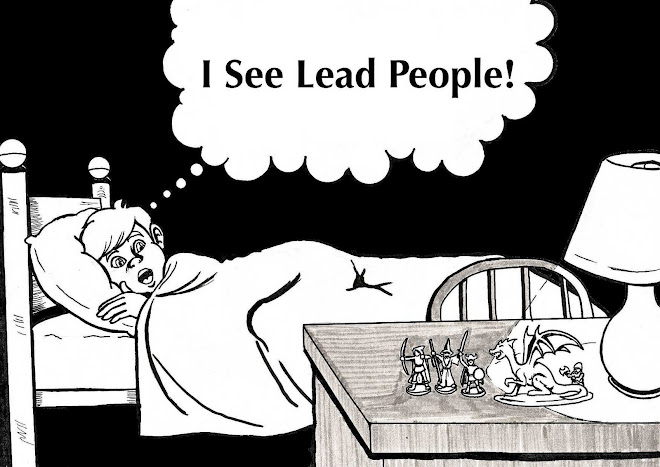So, I got scooped on this by Chad over at Maximum Rock & Role-Play but I figured it was worth commenting on just the same. Brytenwalda, written by Victor Gondra, came up as my buddy Chuck and I were searching for free rules sets to use while scratching an itch for some 28mm Dark Ages wargaming (more on that when I have something to report). Downloaded, printed, and skimmed through the system looks pretty cool. The basic rules (17 pages of actual rules) are written with the Age of Arthur in mind, operating on a warband scale. This is not army on army but more like armed bands duking it out over parcels of land and the like.
Presented here is a brief, at-a-a-glance review of the rules. I feel obligated to say that I have yet to play these rules and so this is solely based on reading through the rules.
Unit Statistics
Stats are kept simple and abstracted - Movement, Combat, Defence, Quality, Talents, and Solidus. The first four (M,C, D, C) are all qualitative scores expressing the relative combat ability of the troop type. It should be noted that there are only two stat lines in the game conscript or veteran with all units having one or the other. These are given more character through the use of talents.
Talents are where some of the less mathematical qualities of the troops come into play. These abilities are expressions of abilities and equipment of the troop type such as shields brutality, ferocity, etc. Each of these talents is either a prerequisite for some sort of rule, a modifier to a rule, or a rule in itself. As an example, only troops and characters with the shields talent can form shield walls.
The last is Solidus (S) which is less a game stat and more a points cost. It's name comes from a form of currency used during the age and adds a nice bit of character to building a warband as you now get the idea of the financial cost outlay your warlord is looking at.
Warband Structure
Warbands are built up from four neat and tidy army lists (they cover two pages) offering Romano-British, Saxon, Scots-Irish, and Picts. These provide the ratios and the talents associated with particular units.
Units in Brytenwalda take the form of one of four types depending on their size - team (3), group (6), band (9), and horde (12). Units are made up of one of either conscripts or veterans. Further classifications as infantry, archers, or cavalry, heroes and chieftains are also used.
System
Brytenwalda has the usual sorts of rules for hand to hand and shooting. The initiative system is not "I go/You go" but rather a reciprocal sort of affair. The player who wins initiative that turn gets to move a unit, then his opponent, rinse and repeat.
There are some fun bits of character to the system such as linked shooting and the ability to add pressure to a defeated unit to help push it into retreat, but the most interesting thing in the system for me is the command rules that require units to receive orders to do things in the game.
The order rules are pretty cool, requiring you to issue commands to units. But it is not a given that a unit will respond properly to these commands and as such a comprehension check is required otherwise the unit continues acting on its last orders. This adds a cool fog of war element.
Scenarios
Brytenwalda is a scenario-driven game and come equipped with six canned scenarios. The following scenarios are included, each with their own sets of special rules and victory conditions -
- Pitched Battle - A straight up fight
- Loot and Plunder - Attacker must sack an objective location.
- Bridgehead - A king of the hill scenario.
- Relic Raiders - A loot race scenario.
- Ambush - Nuff said!
- Kidnapping - Like Loot and Plunder with the objective being a person in the building.
Scenario play is complimented by a simple campaign system that provides methods for linking scenarios, determining the fate of fallen unit and heroes as well as the spoils of war, replacing lost warriors and improving your warband . There is also a system for "Glory and Renown" which allows units to get special campaign-related abilities.
Creating New Units and Warbands
Even this small set of rules includes an appendix which provides points and guidelines for creating new troop types for use in the published warbands or for creating new types of warbands. The nice thing about this points system, unlike some systems allow for build your own units, is it is also the the system used for the published units. This is all done in the spirit of allowing you expand Brytenwalda to include units and warbands not covered in the rules or even in the Arthurian Age at all.
Conclusion
I really like the look of these rules. They are a good set for just throwing some miniatures down without being cold and academic. They allow for character on the table, though not so much that play should be bogged down. Also the inclusion of sample scenarios, campaign system, and unit construction rules is a HUGE plus for me.
Take care all,
-Eli




































































That's really weird Eli, Maff and I have also been looking for free Dark Ages - Vikingesque rules over the past week or so.
ReplyDeleteCheers
Mark
I also found Age of Blood 2nd Edition, which if more of a Vikings miniatures adventures game.
ReplyDelete-Eli
BTW, I blame all the Viking madness on the cold bleak winter :)
ReplyDeletePicked this up a little while ago. We shall see how it plays. Gives me an excuse to paint more Dark Ages. If I don't like them, there's always Pig Wars.
ReplyDelete-J
Have you tried them out Eli? I've just using Featherstone's Skrimish wargaming while we look around
ReplyDelete